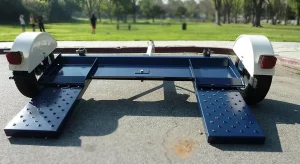Imagine a world where cars intelligently navigate through congested roads, minimizing accidents and safeguarding lives. This vision is closer to reality than one might think, thanks largely to integrating automotive radars into vehicle safety systems.
As we journey through the evolution and integration of radar technology, let’s explore how this innovation is steering us toward a safer future on the roads.
The Science Behind Automotive Radars
At its core, automotive radar technology uses radio waves to detect objects and calculate their speed and distance from the vehicle. This allows cars to ‘see’ through adverse weather conditions and illuminate blind spots, offering a significant advantage over traditional visual-based systems.
The magic lies in the radar’s ability to interpret the reflected signals from objects, painting a dynamic picture of the surroundings vital for decision-making on the move.
The Integration with Artificial Intelligence
Artificial Intelligence (AI) is a beacon for the next leap in automotive radar technology. By incorporating AI, vehicles can process the data collected by radars more efficiently and predict potential hazards with unprecedented accuracy. This proactive approach to safety, underpinned by AI, could drastically reduce human error and further revolutionize how we perceive road safety.
To better understand the sophisticated operation, types, and contributions of these systems toward Advanced Driver Assistance Systems (ADAS), one might explore automotive radar technology in detail. This knowledge enhances the appreciation of their critical role in advancing vehicle safety mechanisms.
Revolutionizing Safety Features
Modern vehicles come equipped with a suite of radar-based safety features. Adaptive Cruise Control (ACC), Automatic Emergency Braking (AEB), and Blind Spot Detection (BSD) are just the tip of the iceberg. These systems continuously scrutinize the vehicle’s environment, making real-time adjustments to maintain safety. Such features epitomize the shift from passive to active safety mechanisms, emphasizing prevention over protection.
The Role of Automotive Radars in Autonomous Driving
Automotive radars are pivotal in the evolution of autonomous vehicles. They form the backbone of the sensor ecosystem, alongside LiDAR and cameras, to create a comprehensive perception of the vehicle’s surroundings. This fusion of data is essential for the intricate decision-making required in fully autonomous driving, from navigating city streets to reacting to sudden obstacles.
Suggestion: 2024 Dodge Viper Review, Price Specification and Released Date
Challenges in Radar Technology Integration
Despite their potential, integrating radars into vehicle systems comes with challenges. Signal interference, especially in congested urban settings, can compromise radar performance. Additionally, the quest for miniaturization continues to push current technology’s boundaries without sacrificing accuracy. Overcoming these challenges requires innovative engineering solutions and constant refinement of radar technology.
Environmental and Economic Impacts
The adoption of radar-based safety systems not only benefits individual motorists but also has broader environmental and economic implications. By reducing the frequency and severity of accidents, automotive radars contribute to decreased traffic congestion, lower emissions, and reduced healthcare and insurance costs. This ripple effect underscores the transformative power of radar technology on our roads and communities.
The Evolution of Vehicle Safety
The future of vehicle safety lies in the hands of radar technology. With ongoing advancements, we can expect radars to become even more sophisticated, offering greater accuracy and reliability. This progression will fuel the development of proactive safety features, minimizing human error and transforming our driving experiences. As we move towards a future of autonomous vehicles, the role of automotive radars in ensuring safety cannot be overstated.
Also Check: 9 Best Car Speakers For Bass and Sound Quality
Global Adoption and Standardization
As automotive radar technology proves its value, we see an increasing trend towards its global adoption and standardization. Such movements not only drive innovation and competition but also ensure that safety features become ubiquitous, regardless of the vehicle’s make or market. International collaboration in the regulatory and technological realms can pave the way for a unified approach to vehicular safety, uplifting standards worldwide.
Empowering the Electric Vehicle Transition
Electrification of the vehicle fleet presents unique opportunities and challenges for automotive radar technology. Electric vehicles (EVs) operate with different dynamics and require innovative approaches to integrate radar systems effectively.
As the world shifts towards greener transportation, ensuring that these vehicles are as safe as possible becomes paramount. The evolution of radars in this space not only complements the transition but also enhances it, making the future of transportation not just cleaner but safer.
Steering Towards a Safer Tomorrow
As we look to the horizon, it’s clear that automotive radars will continue to play a crucial role in shaping the future of vehicle safety. The journey from rudimentary warning systems to intelligent, proactive safety protocols illustrates a profound leap forward in automotive technology. By embracing this evolution, we pave the way for a future where road safety is paramount, and the concept of traffic accidents becomes a relic of the past.







Very interesting blog that i learned more things about cars.